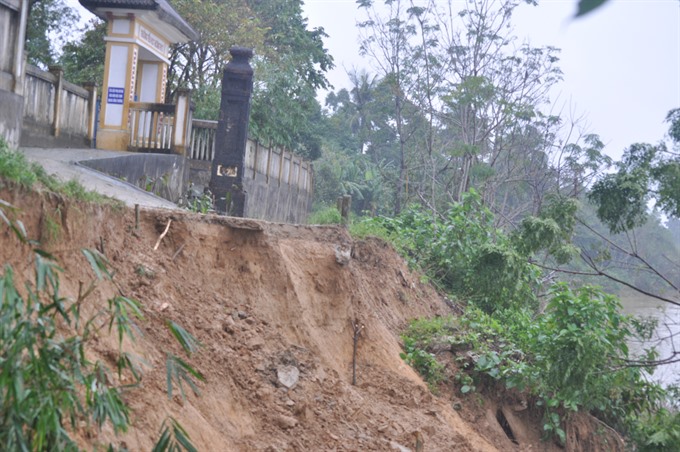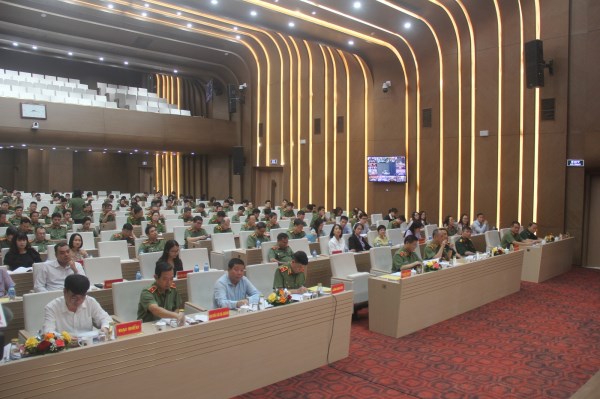 Environment
Environment

Rampant riverbank erosion after recent repeated floods has worried local residents in central Thừa Thiên-Huế as their homes and land property are ready to fall into the broadening rivers.
 |
| Severe erosion on the Hương River bank threatens a school and houses in Hương Thọ Commune. VNS Photo Phước Bửu |
Phước Bửu
THỪA THIÊN- HUẾ — “We woke up from a noon nap to find part of the village’s main road gone!”
Võ Đại Lựa, a resident of Thừa Thiên- Huế Province’s La Khê Trẹm Village, spoke with a mixture of amazement and fear.
“We later recognised a large eroded site, with only the tops of bamboo standing out of the water.”
Lựa was expressing the anxiety felt by many residents of the central province as he continued: “Now I worry about losing my house to landslides or erosion.”
Riverbank erosion has turned into a rampant problem after a succession of recent floods, the latest early this month. Residents are increasingly worried about losing their homes and land to broadening rivers.
The collapse of roads has also impacted daily commuting, adding to the disquiet. The residents’ fears are very real.
“The edge of erosion is just five metres away from my house,” Lựa said.
At one erosion-hit area, water from the Hữu Trạch stream, one of two streams that merge at the Tuần confluence to form the Hương River, has entered 50m inland. The 2km-long erosion in the village also threatens the safety of 295 students at the Hương Thọ Secondary School, with landslides occurring close to the school’s main gate.
The Hương River is not the only one in the province whose banks are being eroded. The banks of the Bồ River in Phong Điền, Quảng Điền and Hương Trà districts have seen serious erosion.
Among the most badly eroded sites is Phong Điền District’s Phong An Commune, where landslides have dug a gaping 100sq.m mouth on the riverbank, forcing local authorities to block one lane of the road to protect commuters from falling into the river.
Trần Lưu Hùng, an employee of the Thừa Thiên- Huế Road Management Public Company, said he and other workers were using bamboo poles and baskets of rocks to temporarily reinforce the riverbank.
“The erosion seems to be worsening day after day, so we are doing this urgently to ensure safety of commuters,” he said.
A report by the local Committee for Disaster Prevention and Rescuing says the recent floods have caused erosion on 70kms of riverbank in the province, and at least 10kms need urgent reinforcement for the safety of nearby residents as well as road users.
The report also said the committee is setting up an embankment project for all erosion-prone sites in the locality.
Reservoirs, sand mining
Residents living near the eroded sites are blaming reservoirs for the erosion and illegal sand mining for worsening the situation.
Trần Công Trai, a resident of Phong An Commune, said he has noticed that the riverbank section in the commune began collapsing year after year ever since the Hương Điền Power Plant, located on the upper part of the Bồ River, started operating in 2010.
“I always felt that the flood current was stronger than earlier natural floods because of water released by the reservoir,” he said. “The riverbank has been collapsing into the river since then.”
Another resident, Lê Minh Đạo, said the repeated flooding caused recently by the emergency release of huge volumes of water by the power plant was so strong that erosion was inevitable.
Sand mining has exacerbated the problem, he added.
“The large scale sand mining on the Bồ River has lowered seasonal water levels, allowing the ‘frog-jaw’ to form beneath the riverbanks,” he said.
The residents’ opinions are backed by experts.
 |
| Workers use bamboo poles and rocks to reinforce the eroded riverbank of the Bồ River. VNS Photo Phước Bửu |
Eliminate reservoirs
Đào Trọng Tứ, former member of Việt Nam’s Mekong River Committee and managing director of the Việt Nam Rivers Network, said both reservoirs and sand mining are responsible for the erosion.
“Power plant reservoirs have completely changed the natural flow of rivers, reducing their water level,” he said, adding that this was causing riverbank erosion.
“During the flooding season, the huge water releases from the plants sets off erosion at the riverbanks and this spreads to other areas.”
Tứ also said that sand mining has hastened the formation of frog-jaw structures at the riverbank and speeded up its collapse.
He warned further that concrete embankments cannot serve as a long-term solution for riverbank erosion. Eliminating power plant reservoirs would work, he said, adding: “Tighter management on sand mining is critical as well.”
Last year, the province People’s Committee declared that strict punishment would be meted out to commune heads unable to stop illegal sand mining in their localities.
However, loose management is still the order of the day. No commune official has been held responsible for his or her management failure. — VNS









